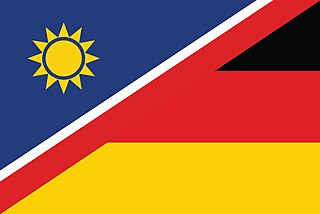| History of Namibia |
|---|
 |
The following is a timeline of the history of the city of Windhoek, Namibia.
| History of Namibia |
|---|
 |
The following is a timeline of the history of the city of Windhoek, Namibia.
| | This section needs expansion. You can help by adding to it. (August 2017) |
| | This section needs expansion. You can help by adding to it. (August 2017) |

Windhoek is the capital and largest city of Namibia. It is located in central Namibia in the Khomas Highland plateau area, at around 1,700 m (5,600 ft) above sea level, almost exactly at the country's geographical centre. The population of Windhoek, which was 486,169 in 2023, is constantly growing due to a continued migration from other regions in Namibia.

German Namibians are a community of people descended from ethnic German colonists who settled in present-day Namibia. In 1883, the German trader Adolf Lüderitz bought what would become the southern coast of Namibia from Josef Frederiks II, a chief of the local Oorlam people, and founded the city of Lüderitz. The German government, eager to gain overseas possessions, annexed the territory soon after, proclaiming it German South West Africa. Small numbers of Germans subsequently immigrated there, many coming as soldiers, traders, diamond miners, or colonial officials. In 1915, during the course of World War I, Germany lost its colonial possessions, including South West Africa ; after the war, the former German colony was administered as a South African mandate. Roughly half of the German settlers were allowed to remain and, until independence in 1990, German remained an official language of the territory alongside Afrikaans and English.
The Deutsche Höhere Privatschule (DHPS) is a private school in Namibia and a German International School Abroad. It is situated in the capital Windhoek.
Clemens Kapuuo was a Namibian school teacher, shopkeeper, president of the Democratic Turnhalle Alliance (DTA), now called Popular Democratic Movement (PDM), and chief of the Herero people of Namibia. Kapuuo was one of the leading opponents of South African rule of his country until his assassination following the Turnhalle Constitutional Conference.

White Namibians are people of European descent settled in Namibia. The majority of White Namibians are Dutch-descended Afrikaners, with a minority being native-born German Namibians. There are also some Portuguese and English immigrants. Estimates published in 2016 suggest that the White Namibian population run between 75,000 and 150,000. This imprecision in data is because the Namibian government no longer collects data based on race.

Wilhelm Sander was a master architect and contractor working for Sander & Kock known for his work in German South West Africa, today's Namibia.

The Turnhalle is a building in Windhoek, the capital of Namibia. Built during the era of Imperial Germany's colonisation of South West Africa, it has been through a variety of uses, most prominently as the venue for the 1975–1977 Turnhalle Constitutional Conference, an attempt to quell armed resistance waged by the People's Liberation Army of Namibia against South African occupation. The Turnhalle housed the Tribunal court of the Southern African Development Community (SADC) until disbandment in 2012.
The following is a timeline of the history of Cape Town in the Western Cape province of South Africa.
The following is a timeline of the history of the city of Kampala, Buganda, Uganda.
The following is a timeline of the history of the city of Johannesburg, in the Gauteng province in South Africa.
The following is a timeline of the history of the city of Gaborone, Botswana.
The following is a timeline of the history of the city of Bamako, Mali.
The following is a timeline of the history of the city of Niamey, Niger.
The following is a timeline of the history of the city of Libreville, Gabon.
Mass media in Namibia includes radio, television, and online and print formats.
The following is a timeline of the history of the city of Yaoundé, Cameroon.
The following is a timeline of the history of the city of Monrovia, Liberia.
The following is a timeline of the history of the city of Bujumbura, Burundi.
The following is a timeline of the history of the city of Durban in the eThekwini Metropolitan Municipality, KwaZulu-Natal province, South Africa.
The following is a timeline of the history of the city of Kigali, Rwanda.
Windhuk
South West Africa
{{cite web}}: CS1 maint: unfit URL (link){{cite book}}: |author= has generic name (help)CS1 maint: location missing publisher (link)This article incorporates information from the Afrikaans Wikipedia and German Wikipedia.
Windhoek. via Google Books
{{citation}}: CS1 maint: location missing publisher (link)